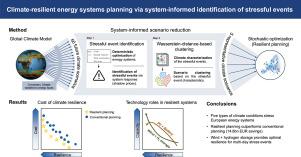Climate-resilient energy systems planning via system-informed identification of stressful events
IF 13.8
Q1 ENERGY & FUELS
引用次数: 0
Abstract
As the energy mix increasingly relies on weather-dependent renewable sources, energy systems become more vulnerable to climate variability and extremes. However, current planning approaches struggle to incorporate climate uncertainty in the design phase while maintaining computational tractability. We address this challenge by developing a framework that combines system-informed scenario reduction and stochastic optimization to design climate-resilient energy systems. Our method reduces data complexity by identifying representative climate scenarios that capture stress events through system response. Remarkably, five distinct patterns of multi-day energy shortages emerge across Europe, each characterized by different combinations of renewable resource availability and demand profiles. Stochastic optimization then incorporates these representative climate scenarios with their associated probabilities to design energy systems that are resilient across the full spectrum of climate variability. Results show that climate-resilient designs consistently outperform conventional single-climate designs, achieving lower costs (on average 14.8 bn EUR) for equivalent resilience levels. We identify two trade-off regions with different marginal costs of resilience: a low-resilience and a high-resilience region where marginal costs increase fivefold. Despite higher costs, trade-offs between the cost of resilience investments against energy not supplied justify pursuing the high levels of resilience. Combinations of onshore wind and hydrogen storage emerge as effective mitigation against multi-day events of energy shortage. This framework provides energy planners and policymakers with quantifiable insights into resilience investment strategies and technology selection for future climate-aware energy planning.

通过系统信息识别压力事件进行气候适应型能源系统规划
由于能源结构越来越依赖于依赖天气的可再生能源,能源系统变得更容易受到气候变化和极端事件的影响。然而,目前的规划方法难以在保持计算可追溯性的同时,将气候不确定性纳入设计阶段。我们通过开发一个框架来解决这一挑战,该框架结合了系统知情情景减少和随机优化来设计气候适应性能源系统。我们的方法通过识别通过系统响应捕获压力事件的代表性气候情景来降低数据复杂性。值得注意的是,整个欧洲出现了五种不同的多日能源短缺模式,每种模式都以可再生资源的可用性和需求概况的不同组合为特征。然后,随机优化将这些有代表性的气候情景与其相关的概率结合起来,设计出在整个气候变率范围内具有弹性的能源系统。结果表明,气候弹性设计始终优于传统的单一气候设计,在同等弹性水平下实现更低的成本(平均148亿欧元)。我们确定了两个具有不同弹性边际成本的权衡区域:低弹性区域和边际成本增加五倍的高弹性区域。尽管成本较高,但在弹性投资成本与未供应能源之间进行权衡,证明了追求高水平弹性的合理性。陆上风能和氢储存的结合成为缓解多日能源短缺事件的有效手段。该框架为能源规划者和政策制定者提供了可量化的关于弹性投资战略和未来气候意识能源规划技术选择的见解。
本文章由计算机程序翻译,如有差异,请以英文原文为准。
求助全文
约1分钟内获得全文
求助全文

 求助内容:
求助内容: 应助结果提醒方式:
应助结果提醒方式:


